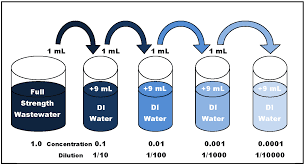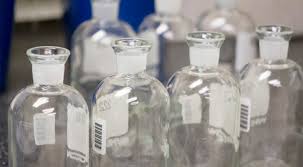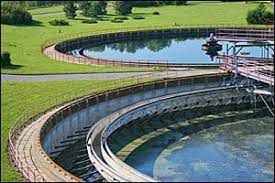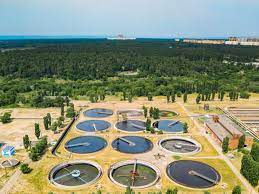9 Types of Biochemical Oxygen Demand (BOD)
Below are the 9 different types of biochemical oxygen demand (BOD) and there are slight difference between ordinary BOD and BOD5 as we explained below:
1. Biochemical Oxygen Demand
BOD or Biochemical Oxygen Demand is the quantity of dissolved oxygen consumed by micro-organisms during the microbial and chemical oxidation of the constituents contained in a waste-water sample during an incubation period at a given temperature.
The biochemical oxygen demand represents the oxygen utilized during the oxidation of both carbon and nitrogenous compounds.
2. Biochemical Oxygen Demand (BOD5)
BOD5 or Biochemical Oxygen Demand 5-day is the quantity of dissolved oxygen consumed by micro-organisms during the breakdown of organic matter in a waste-water sample during a 5-day incubation period and measured in mg/L at 20oC. It is used as a means to describe the amount of organic matter present in the water.
Biodegradable organic matter is provided in terms of pounds of BOD5 per person (capita) per day by using the BOD5 concentration and daily flow.
Biochemical oxygen demand is a measure of the oxygen required by bacteria, chemicals, and other organisms to break down organic matter over a five day period. It is an indicator of the overall strength of the waste-water.
Most designs assume that all residential sources generate a concentration of 300 mg/L of BOD5, and after pretreatment in a properly sized septic tank the BOD5 is reduced to approximately 170 mg/L However, these concentrations can vary from site to site.
Read Also: Types and Sources of Waste-Water
3. Carbonaceous Biochemical Oxygen Demand (CBOD)
CBOD or Carbonaceous Biochemical Oxygen Demand is the quantity of dissolved oxygen consumed by micro-organisms during the breakdown of organic carbon in a waste-water sample during an incubation period of 5 days at 20°C.
An inhibitor is placed in the sample to prevent growth of nitrogenous oxidizing microbial populations. It is used as a means to describe the amount of organic carbon present in the water that can be broken down with microbial processes.
4. Nitrogenous Biochemical Oxygen Demand (NBOD)
NBOD or Nitrogenous Biochemical Oxygen Demand is the quantity of dissolved oxygen consumed by micro-organisms during the oxidation of nitrogenous compounds such as protein and ammonium in a waste-water sample during an incubation period of 5 days at 20°C.
It is used as a means to describe the amount of organic nitrogen (such as urea, proteins, etc.) present in the water. It is not usually used in typical waste-water analysis.
5. Ultimate Biochemical Oxygen Demand (UBOD)
Ultimate Biochemical Oxygen Demand is the measure of the oxygen required to complete the breakdown of the organic matter.
The UBOD consists of summing the oxygen demand required to oxidize the organic matter in the waste-water, synthesize the organic matter into new cell tissue, and the endogenous respiration where cell tissue is consumed by other microbes to obtain energy for cell maintenance. The UBOD is not typically a value measured in lab analysis.
6. Chemical Oxygen Demand (COD)

Chemical Oxygen Demand (COD) is a measure of the amount of organic matter oxidized by a strong chemical oxidant. COD is used to measure organic matter in commercial, industrial, and municipal wastes that contain compounds toxic to biological life where the BOD5 test would not work.
The COD levels in a waste-water sample are almost always greater than BOD5 levels because more compounds can be chemically oxidized in the COD test than can be biologically oxidized in the BOD test.
In most cases, once the COD/BOD5 relationship is known for a particular facility, the COD concentration of a sample can be used to approximate the BOD5 concentration.
The COD test can generally be done within 2.5 hours, whereas a BOD5 test takes five days. A COD test is performed when a quick determination of oxygen demand is needed.
7. Dissolved Oxygen
Dissolved Oxygen (DO) is the amount of oxygen dissolved in water. It is influenced mainly by temperature, barometric pressure (altitude), and water salinity. As temperature decreases, the amount of dissolved oxygen that can be accepted by water increases until it becomes saturated.
The three oxygen states are aerobic, anaerobic, and anoxic conditions. The term aerobic is defined as having molecular oxygen (free oxygen, O2) as a part of the environment or a biological process that occurs only in the presence of molecular oxygen.
An anaerobic condition is the absence of molecular oxygen as a part of the environment or a biological process that occurs in the absence of molecular oxygen but can utilize oxygen bound in other molecules, such as nitrate (NO3-).
Anoxic is the condition in which all waste-water and/or effluent constituents are in their reduced form, meaning there are no oxidants present.
The micro-organisms (bugs) that are used for biological treatment can be categorized by the state of oxidation in which they operate. These categories of micro-organisms include:
- Aerobes – thrive in aerobic conditions
- Anaerobes – thrive in anaerobic conditions
- Facultative – thrive in both aerobic and anaerobic conditions
Free oxygen (O2) is needed for aerobic treatment to take place, and aerobic bacteria need oxygen to grow and live. Aerobic organisms respire dissolved oxygen contained in the water. Anaerobic bacteria grow and live in the absence of free oxygen.
Facultative organisms have the ability to respire free oxygen when it is available and shut down the respiration process when dissolved oxygen is lacking. The table below gives the desired ranges of DO in waste-water.
Anaerobic bacteria are significantly slower at oxidation and smaller in size than aerobic bacteria, but they are much more resilient to environmental changes.
Aerobic micro-organisms are more sensitive to waste-water parameters (such as DO, pH and temperature), but in optimal conditions, they digest organic matter and pathogens more rapidly than do anaerobic organisms.
Table 3.2: Ideal Dissolved Oxygen Range in Waste-water
| Microbe | Anaerobe | Facultative | Aerobe |
| Low DO (mg/L) | 0 | 0 | 0.5 |
| High DO (mg/L) | 0.5 | 5 | 5 |
| Typical (mg/L) | 0-0.3 | 0-1 | 1-3 |
The septic tank is typically considered an anaerobic treatment component, although there can be aerobic zones. For the most part, septic tank microbes assimilate the waste constituents in the absence of a respiration process and are commonly referred to as anaerobic microbes.
Facultative microbes utilize free oxygen or assimilate waste without respiration. During assimilation of waste, the bonds holding the oxygen are broken.
Read Also : Guide to Recycling of Wastes and Advantages of Recycling
8. Total Suspended Solids (TSS)
Total Suspended Solids (TSS), is a measure of the solids that remain in the waste-water after settling has occurred in the tank. A typical TSS value is 60 milligrams per liter. BOD and total suspended solids together measure the strength of the waste-water. They can serve as an indicator of system performance.
Total suspended solids or TSS is the most common measure of the amount of solids in waste-water effluent. TSS is the measure of all suspended solids in a liquid, typically expressed in mg/L.
It is measured by filtering a well-mixed sample through a standard glass fiber filter and drying the residue retained on the filter at 217 to 221 degrees F (103 to 105 degrees C). The increase in the weight of the filter represents the amount of total suspended solids.
Other terms and measurements of solids in waste-water treatment systems are:
Solids, settleable: suspended solids that will settle out of suspension within a specified period of time, expressed in milliliters per liter (mL/L)
Solids, total (TS): mineral, cells, etc. left in waste-water after evaporation of the water fraction at 103 degrees C, typically expressed in mg/L
Solids, total dissolved (TDS): material that passes a standard glass fiber filter, and remains after evaporation at 103 degrees C, typically expressed in mg/L
Solids, volatile: weight loss on ignition of total, solids, not distinguishing between inorganic and organic matter and including loss due to decomposition or volatilization of some mineral salts at 550 degrees C
TSS and BOD5 are typically the two parameters used to measure waste- water strength and treatment performance relating to organic/inorganic matter. TSS (as stated earlier) is measured by performing a solids analysis but can also be estimated by a turbidity test.
Turbidity is the physical clarity of the water and is an indicator of the presence of suspended matter in waste-water. A ―quick and dirty‖ TSS test can be determined with an Imhoff Cone. A visual test will determine if TSS levels are high or low when a sample of waste-water is placed in a cone against a light background.
9. Fats, Oils and Grease (FOG)
FOG (fats, oils, and grease) is a constituent of sewage typically originating from food stuffs (animal fats or vegetable oils) or consisting of compounds of alcohol or glycerol with fatty acids (soaps and lotions), typically measured in mg/L.
Sources of FOG: Fat found in on-site waste-water treatment systems is animal fat, oil is from vegetable and cooking oils, and grease is from petroleum based soaps. FOGs are generally treated in on-site waste- water treatment systems by separating them from the waste-water stream.
At high temperatures FOG are in a liquid state, but as the temperature cools, the fats component will solidify. FOG can be trapped in pretreatment components, such as septic tanks and grease traps, where they typically float to the top of tanks.
They are less dense and lighter than water. It is important to try to contain FOG early in the system, because they can accumulate inside pipes and lead to clogging of downstream components.
FOG also contributes to BOD and TSS concentrations. FOG in excessive amounts interfere with aerobic biological processes and lead to decreased treatment efficiency. The expected levels of FOG concentration must be considered during waste- water treatment design.
FOG in domestic waste-water will generally originate in the kitchen or bathroom. Kitchen FOG usually comes from disposing animal- or vegetable-based food scraps and liquids down the sink.
Households using garbage disposals will have 30-40 percent more FOG than households not using garbage disposals. Bath oils, sun tan lotions, hair conditioners, and moisturizing creams are bathroom sources of FOG that enter the waste-water stream.
An increased use in cooking oils, lotions, and hair conditioners will directly increase the FOG concentration in the waste-water. Low FOG, although it is not considered a problem, could be the result of not using the kitchen or of higher than normal flows entering the system. Low FOG can also be attributed to the use of bar soap instead of liquid soaps.
The waste strength of sewage and effluent as it passes through a treatment system can indicate the performance of a septic system. Understanding how these components enter the waste stream and are removed through the treatment process is critical for system designers and service providers.
Read Also: Growing and Care Guide of Clover Seed



